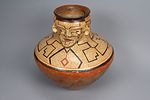Jar
About this object
History of use
Shipibo pottery derives from an artistic tradition which appears to be indigenous to the Amazon Basin (Willey) reaching its fullest development among the Panoan speakers of the upper Amazon, such as the Shipibo. The geometric designs found on this pottery are also found on wooden objects such as paddles, textiles, and used for body decoration. According to Salas, these patterns derive from a cross and serpent theme. Characteristically, designs are formed by heavy and fine red and black lines on cream. Traditionally, uses ranged from pots for boiling meat and fish, bowls for eating, Chicha vessels for storing beer and effigy vessels for female puberty rites. The expansion into the art or tourist market is evidenced by the establishment of a pottery school, and individual recognition of a few potters for their skill (Salas). The kené, or design is executed by women and taught by practice from one generation to the other. Kené motifs are revealed to specific people via icaruses, the songs shamans perform in ayahuasca ceremonies. The term ayahuasca refers to both the vine of a plant, Banisteriopsis caapi, and the drink made by boiling in water a mixture of ayahuasca and either chacruna (Psychotria viridis) or cahua (Diplopterys cabrerana). At the ceremony, the shaman drinks the brewed mixture to help gain access the spiritual world. Like chanting, painting connects the four worlds of the Shipibo worldview. The world where we live includes humans, animals, plants and all their spirits; it relates to the world of the waters, inhabited only by spirits. The yellow world, by contrast, is the domain of evil spirits and wrongdoings, while the world of the sun is where the spirits of humans, animals and plants go to live in the end. Powerful shamans visit this last world when they drink ayahuasca, assuming the form of a jaguar, boa or puma.
Narrative
The Shipibo live along the Ucayali River, a southern tributary of the Upper Amazon in Peru. In the 18th century they joined forces with traditional enemies to drive away missionaries and other foreigners. From the late 1800s to the 1920s they were enslaved by the caucheros, rubber entrepreneurs, and forced by violence to meet rubber production quotas. The caucheros were in turn employed by foreign companies, notably the infamous Anglo-Peruvian Amazon Rubber Co. Today, the c. 36,000 Shipibo are under pressure from the neighbouring Spanish-speaking mestizo population, commercial fishermen who have depleted their traditional waters of fish, turtles, and manatees, destroying their subsistence base. Money from tourism, primarily through women’s arts — textiles, jewellery and pottery — has become crucial to buy the food, medicine and access to Western education that will allow the Shipibo to survive in the modern world.
Cultural context
pottery; tourist art
Iconographic meaning
Specific techniques
Shipibo pottery is made by women from clay mixed with the siliceous ashes of the caraipe tree and finely ground pottery remains. Bowls, plates, jugs, ceremonial pitchers and anthropomorphic jars and vessels are built by coiling and modelling, then scraped, smoothed and pebble polished. They are slipped and painted, and traditionally fired in rudimentary earth ovens. Finished pieces are resin varnished. Some interiors are soot blackened over a fire. Traditionally clays are used for the painted designs.
Physical description
Polychrome effigy jar with flared lip, bulbous at top of neck, the rest of the neck slopes slightly, then sharply flares to shoulder and constricts sharply to flat 18 cm. base. Modelled face on neck with protruding ears, nose and chin. Slits at eyes and mouth. Rectilinear dark brown and orange on light yellow/brown design from neck to shoulder. Thick dark brown lines mark off areas in straight and stepped lines and zigzag connections. Some orange lines and fine dark brown lines infill spaces. Occasional x's on these lines. Orange diamond below face, brown zigzag at forehead. Orange for bottom half and at inside rim. Black and light brown patches around bottom. Plain inside. Resin coated inside and out. Scrapes and chips at shoulder. Dirt accretions and checked patches. Paint chipped on face.
